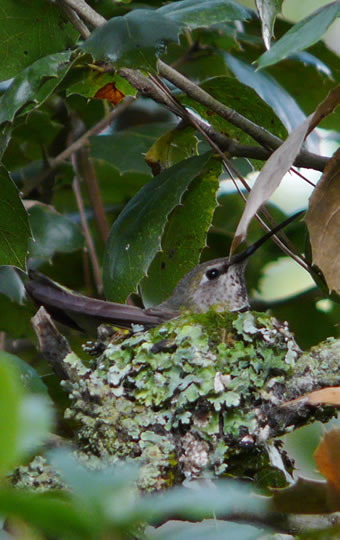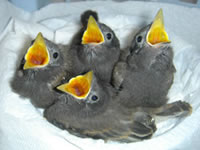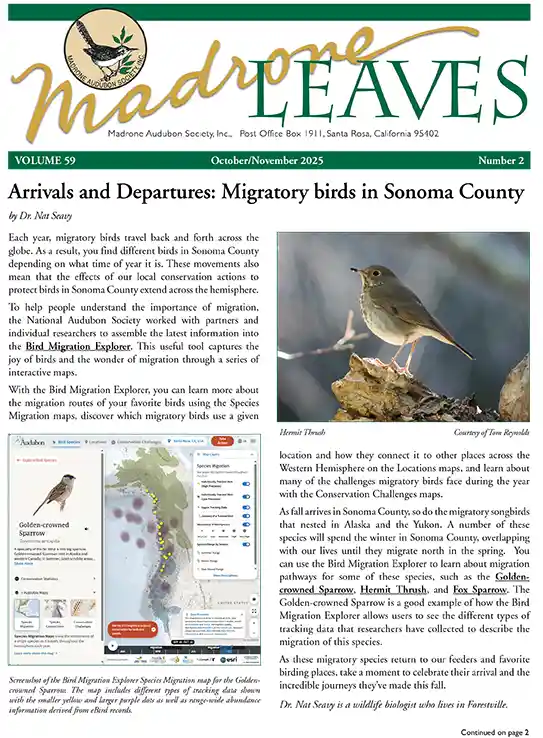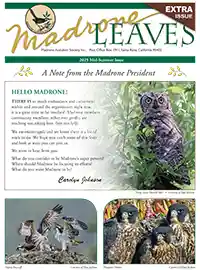Nesting Season, or When is it safe to Trim Trees?
The short answer: from October through January
Found a Baby Bird? click here.
Nesting Season - Do Not Disturb!

Anna's Hummingbird on nest
The following article is from Native Songbird Care and Conservation
Just like humans, songbirds build homes to raise their families. While many people think songbirds only nest high up in the trees, the truth is they nest everywhere. Songbirds nest in trees as well as bushes, cavities and even on the ground; some build nests on human dwellings, bridges and other human-made structures. They use an assortment of materials to construct their nests: mud, plant fibers, animal hair, moss, lichen, tree bark, twigs, saliva, spiders silk and even human trash such as string, dryer lint and cellophane. The materials and construction design of the nest keep eggs and chicks protected and warm.
From March through early September, Sonoma County is home to 90 different resident and migratory species of native songbirds (or passerines) that will breed and raise their young. Unfortunately, this period of time also coincides with the time of year that many human residents of Sonoma County trim trees and shrubs and clear brush from their backyards and property. These activities can destroy active nests and reduce the availability of valuable nest sites for our songbirds. It is best to avoid the nesting season and save backyard maintenance projects of this sort for late fall and winter.
If you must trim a tree or prune a shrub during the breeding season, carefully inspect the area before you begin the project. Most songbirds are masters at concealing their nests, making it very difficult for the observer to spot an active nest. A songbird nest can be as tiny as 1.5 inches in diameter to as large as 1.5 feet. Most are 3 to 6 inches in diameter, they're small and well camouflaged. To detect an active nest, quietly observe the proposed project area from a distance of about 50 feet. Watch for birds entering the tree or bush and listen for the food call of young or calls of an adult. Watch for adult birds in your yard actively collecting food and observe where they fly to deliver the food. Look and listen as you approach the proposed project area. Are you being scolded by an angry bird? If so, there is a nest nearby. Are you being dive-bombed by a bird? Again, if the is answer is yes, there is a nest nearby.
If you begin trimming, pruning or clearing vegetation and discover an active nest, you must cease the work immediately. All native birds, their chicks, eggs and active nests are protected by a federal law called the Migratory Bird Treaty Act as well as California State Codes 3503 and 3503.5. In a nutshell, these laws state that it is unlawful to harm, harass, possess or kill a native bird, its eggs, chicks or active nest. Violation of these laws result in heavy fines and sometimes even jail time.
If you observe someone destroying or disturbing an active nest, report them immediately to California Department of Fish and Wildlife at (888) 334-2258 and United States Fish and Wildlife Services at (916) 414-6660. Be prepared to provide the exact location, as well as vehicle license plates and company name if applicable. If possible, take photos and collect evidence (dead or live chicks, broken eggs).
Active nests cannot be disturbed or moved to another location. Parent birds choose a nest location for very specific reasons. Safety from predators, protection from the elements and proximity to food and water are important criteria birds use to select the perfect nest site — not too different from the criteria we humans use. Disturbing or relocating an active nest is a form of harassment, which is a violation of the laws that protect the birds. This form of harassment can also cause parent birds to abandon their chicks or eggs.

If you accidentally displace a songbird nest, call NSCC at (707) 484-6502. We can help you with a solution that will keep the babies safe and with their parents. With careful observation and good planning, you can help protect great numbers of songbirds from the destruction of their nests and young. In turn, our native songbirds can achieve breeding success and healthy populations, and continue to grace the natural world with their beauty and ecological benefits.
For more information about other ways to help keep songbirds safe, visit www.nativesongbirdcare.org
A copy of this article is at the following address: http://nativesongbirdcare.org/uploads/Nesting_Season_-_do_not_disturb.pdf
Find us on Facebook 
It's Nesting Season: trim trees in the Fall!.
Amazon Smile: donate to Madrone when you shop
Birding Quiz - test your skills.
Leaves Newsletter


Carved Bird Pins
In the 1970s, member Tom Olds hand-carved bird pins and sold them to raise money for Madrone Audubon. More